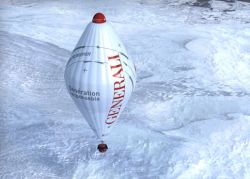Generali Arctic Observer
Expedition News-Official Website
From 11.04.2010 to 25.05.2010 - Status: success
Jean-Louis Etienne is aiming to fly over the Arctic Ocean aboard a helium-and-air balloon. "This," he says, "will be part three of my trilogy of solo expeditions to the North Pole..."
We should start by recapping on the previous two Arctic adventures completed by the French doctor and explorer: in 1986, Etienne became the first man to reach the geographic North Pole solo, hauling his sledge behind him for 63 days; then, in 2002, he drifted alone in the sea-ice for four months aboard his floating pod, Polar Observer, making a significant number of scientific observations. Later, during the International Polar Year 2007-2008, Etienne saw his dirigible Total Pole Airship', aboard which he had also intended to fly over the Arctic sea-ice, destroyed by a gust of wind when it was blown against the side of a house, with disastrous consequences.
This time, Etienne will be flying aboard a strange-looking oblong-shaped balloon (see photo). The balloon itself is a Rozière', lifted by a mixture of helium and hot air. It was designed and built by the British aeronautical engineer, Don Cameron, and is the same type as the Breitling Orbiter in which Bertrand Piccard and Brian Jones flew around the world. The balloon's pod has been specially constructed for this polar crossing.
The balloon envelope is made from polyester and nylon and holds 2 200 cubic metres of helium and 500 cubic metres of hot air. It measures 25 metres in height and is 16 metres in diameter. When the propane is combusted in the two burners located above the pod, it heats the helium, which expands and lifts the balloon. The balloon descends spontaneously as the gas cools, or by opening the helium release valve at the top of the envelope. The balloon will carry 360 kg of propane for this flight in 12 tanks located throughout the pod. This will provide enough fuel for 15 to 20 days of flight.
Two constant readings will be taken throughout the flights (between Spitsbergen and Alaska): the level of CO2 in the atmosphere, for the Laboratory of Climate and Environmental Sciences - CEA-CNRS, and the Earth's magnetic field, for the Institute of Global Physics in Paris-LETI-CEA.
At his press conference, Etienne stated: "I intend to use this daring adventure, which is worthy of a Jules Verne story, to draw the world's attention to the shrinking of the sea-ice and its effects on the ethnic peoples of the area and Arctic biodiversity, as well as the climate-related chaos that the total disappearance of the ice would cause on a global scale. The Arctic sea-ice is the best barometer we have for measuring the performance of the efforts that humans have to make to combat climate warming..."











